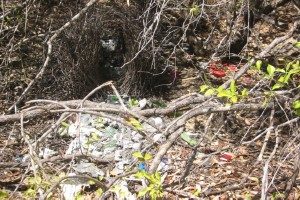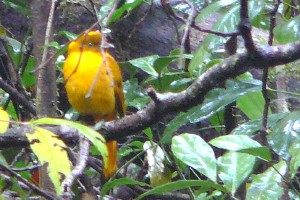- Australia Intro
- 1. A Primitive Bird in Queensland
- 2. Among the Eucalypts
- 3. Avian Architects and Artists
- 4. Cranes, Wetlands and Australian Tucker
- 5. Tasmania’s Rare Outback Birds
- 6. A Critically Endangered Species
- 7. Tasmanian Devils, Holey Ground and a Barbie
- 8. The Feathered Thief at Cradle Mountain
3. Avian Architects and Artists

The bower consisted of many twigs about eight to ten inches long. The male bowerbird that built this enclosure had stabbed the sticks into the soil to form two thick sides about three feet long. Chris explained that if a bowerbird doesn’t like the way a particular twig is oriented, he pulls it out and stabs it in the dirt again, rearranging each stick until it is perfect in his eyes. The tops of the twig tips touched, forming a tall, narrow, inverted V-shaped tunnel. On each side of the tunnel’s mouth the bowerbird placed bits of plants, small rocks, and sometimes pieces of plastic. On this particular bower, everything on the left side was white and on the right side, red. Later, I learned that all species of bowerbirds are known for their unique and ornate bowers, even decorating them by chewing up fruits and mixing the juice with their saliva to create a “paint.” Satin Bowerbirds have a different specialty. They have blue-black plumage, so they create bowers using blue objects in order to highlight their own blue attributes.
Bowers are not nests, but are considered “bachelor pads” used to attract females for mating, but not chick rearing. A male will return to his old bower year after year to repair it and collect fresh decorations. He might use berries, flower petals, string, live insects, even coins, nails, straws, and an assortment of other human-made, colorful objects that he determines will attract a female.
“Bowerbirds eat mostly fruit that is usually easy to find,” Chris noted. “Sadly, the bird that built this bower probably had to abandon it due to the drought that has plagued Queensland for several years. There’s less food here now, so this one must have moved to where there’s more to eat.”
Bowerbirds vary in color, some plain and some with bright coloring, but it is not their plumage that is the key to finding a mate. The males use dramatic vocalizations, along with their creative bowers to attract the females. Each species has a specific design for its bowers. Several use the basic design we saw with twigs stabbed into the ground to form a tunnel. The tunnels vary in length, width, and height at the mouth and some resemble a cave. Other species of bowerbirds surround the base of a small tree with their special upright twigs and then decorate the ground around the trunk with carefully chosen objects.
Bowerbirds’ Aesthetics
John Endler, Ph.D., is one of the world’s leading evolutionary biologists and a pioneer of a new science, Sensory Biology. He is a professor and researcher based at Deacon University, Australia, and has studied bowerbirds extensively. Great Bowerbirds create elaborate bowers that Dr. Endler describes as being made with an awareness of “art and aesthetic” in order to attract females for courting and mating. By placing the found objects so that the smallest ones are close to the mouth of the bower and the larger objects are further away, these bowerbirds create an optical illusion that the pieces are all the same size. When the female bowerbird is inside the bower and looks out at the male, he seems larger and more attractive to her.
Ornithologists have tried moving the colorful decorations that a certain bowerbird has meticulously placed to create his unique bower. When the ornithologists changed the designs and objects, the male bowerbird restored every treasure to its proper place. One surprised scientist studying a Vogelkop Bowerbird’s creation found a heap of deer droppings inside his cave-like structure. The droppings had sprouted tiny, white, fungi like miniature mushrooms. The fussy bird plucked off the fungus stems as they grew, preferring the clean look of the round pellets.
To enhance the magnetism of what the media describes as the bowerbird’s “ultimate seduction parlor,” the male may also engage in a creative dance to seduce an approaching female, using flared wings, hops, or quivers. The curious female will inspect the bower and she may or may not find the male’s twiggy lure and dances attractive. After she mates with her chosen male, she still has to build her nest and take care of the chicks while he quickly returns to decorating his bower until the next female succumbs to his charms.
Of course, I would love to say that I saw all of these birds and their bower building, dancing, and mating, but I did not, though videos of their dances certainly got my attention in preparation for my tour. Alas, bowerbirds like privacy and save their dancing for their possible intended. Sorry to say, birders are not their love objects. I had to satisfy myself with seeing the unoccupied bower and imagining the activities that occurred there. Fortunately, patient professional wildlife videographers have captured the bowerbirds’ courting and mating rituals, which are fascinating to birders like me who long for a glimpse into their world.
A Peril of Birding

In a quiet rural area, we pulled off near an abandoned road that pierced the thick brush. I wondered what we were doing since nothing indicated this spot was special. Del beckoned us to follow him down the overgrown track bordered with medium-sized deciduous trees. Five of us kept up with Del, leaving the rest of the group to follow at a slower pace. We climbed over and under fallen logs and brushed past the wet bushes seeking a bowerbird.
In ten minutes, the track had faded and Del made a right turn into the shrubbery. We pushed our way into the wet forest through tangled grasses and low hanging branches until Del stopped. He turned to us and patted the air, signaling that the bird was nearby. Then he pointed, his hand close to his chest so he would not startle the bird. We followed his point. A bright yellow bird sat on a low branch back in the underbrush. Del whispered, “Golden Bowerbird.”
The robin-sized bird hunkered peacefully on a thick wet branch about four feet off the ground. Mossy branches blocked a clear view so we quietly jockeyed for a good position. The brilliant yellow body with olive-green wings, upper tail and face matched Del’s earlier description.
As I stepped back to let new arrivals see better, a distant scream ripped the silence. At first, I was annoyed, then worried that the bird might fly. He looked in the direction of the noise but did not react. I wondered, Has this bird heard those screams before?
Finally, I realized that the distant howls belonged to my friend Sally, so I turned to retrace my steps back up the trail. Sally continued her yelping, interspersed with short periods of quiet. I met two others in our group who said she had been with them when they discovered leeches on their pant legs. They picked off the leeches and kept moving—but Sally went ballistic. We were in prime leech habitat—warm, moist, and brushy—and the previous night’s rain activated them.
As the others kept walking to join Chris, I stopped to check my clothes and found a few of the thread-thin creatures hunching up my pant legs. I picked them off and continued my search for Sally. She was near hysterics when I found her. “I fell behind the others and missed the turn off and started back to the bus and was climbing over that tree across the track when I found a leech on my leg,” she gasped, her face contorted in disgust. “No bird is worth all of this.”
I tried to calm her. It seemed best to move away from that spot so I spun her around and pointed her in the direction of the road.
Once we reached the van, I began a thorough inspection of clothing and body—hers and mine. Leeches are really quite innocent but the first time I saw a leech hiking up a companion’s sleeve, I was as disgusted as Sally, although not so vocal. Land leeches are about an inch long, move like an inchworm, thread-thin and hard to see. They wait on the end of a blade of grass or twig for anything warm blooded to brush by, just as a tick will do. They grab hold, move upward and through clothing until they find bare skin. Then they clamp on for a meal. While feeding, the leech’s body swells with blood to many times its original size. I must admit a blood-filled leech is a disgusting thing to find hanging from one of your body parts.
Leeches inject a blood-thinner similar to that of mosquitoes. When they are fully engorged and drop off, the wound bleeds for a few minutes, which is often the only indication they were even there at all—which is my preference if I am to be a dinner donor! However, I prefer to find leeches before their meal begins. They can be flicked off clothes relatively easily, but once they find skin, even if you try to move them, they hang on. At that point, flicking only results in a leech attached to the flicking finger. I read that Phoebe Snetsinger, a famous birder, carried fingernail scissors for such situations, noting that half a leech can’t do its job well. Some people carry solid bug repellent and swear that just a touch makes them drop off. After years of traveling and encountering numerous leeches, I just didn’t worry much about them anymore.
For Sally, leeches were a traumatic encounter, so I patiently checked for the little hangers-on. We were almost done with our own inspections when the others returned, casually removing leeches as they walked. Once leech-free, everyone climbed back on the van. However, the drama continued. As we began to relax, another shout filled the air. Someone else had found one of the persistent devils in mid-feast, and managed to flick it off onto the van floor. Of course, unfazed, the leech just inched its way to the next warm body.
All of this just to see a bird? Was it worth it?
Of course, it was.